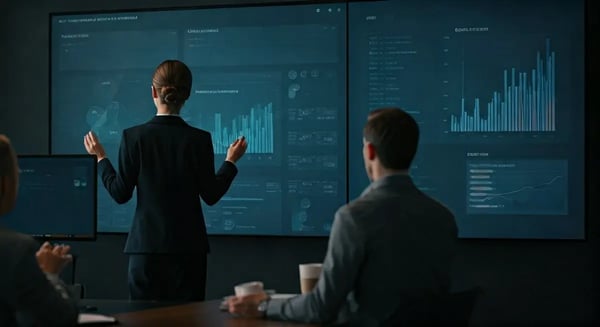Process Improvements Opportunities in 2025
Key Highlights
- Process improvement in 2025 focuses on enhancing efficiency, adapting to customer demands, and achieving operational excellence.
- Lean Six Sigma, Agile, and technological integration such as AI and machine learning are pivotal for continuous improvement efforts.
- Emerging technologies, like robotics and cloud computing, are transforming traditional processes, leading to cost savings and scalability.
- Industry-specific examples show the impact of process optimization on manufacturing, healthcare, financial services, and retail.
- Success metrics, like KPIs and ROI analysis, evaluate process improvement methodologies and their alignment with business goals.
Introduction
Are you working hard to keep up with new business needs and keep your customers happy? Process improvement is one of the key ways to make the value stream better. It helps bring all improvement efforts in line with big goals. When you work to improve current processes, you can make workflows run smoother. This helps you to lower operational costs. It can also open the door for new chances and growth.
In 2025, better methods and new technology will play a big part in this process. The focus will still be on building a strong culture of continuous improvement in your business operations. This will help you stay ahead of others and get a good competitive advantage. Let’s look at how process improvement helps shape business success today.
Understanding Process Improvement
Process improvement is all about making workflows better and fixing what slows things down. The goal is to find and stop things that cause problems or take too long. By using approaches like Lean Six Sigma and Theory of Constraints, a business can make the most of its people and tools. With these methods, your team can keep getting better at what they do and meet high-quality standards at the same time. This also lets companies move fast, so they can keep up when market changes happen or when customers want something new.
There are many good things that come with structured ways of working on process improvement. Not only do these methods help a business work better, but they also build trust and open talk between team members. It helps to have a culture where everyone likes finding ways to make your current processes better. Teams can handle problems in a clear way, using facts, useful ideas, and best practices. By following this path, a company can check that its current processes always fit what it needs now and later on. That’s why process improvement is so important if you want to keep up in a fast-moving world.
Definition and Importance in the Modern Era
Process improvement, also called continuous process improvement, is about looking at current processes to make them work better. The goal is to use best practices to help get rid of waste and things that slow you down. People do this by finding out what causes problems and working to fix them. As more companies around the world try to improve business operations, this idea has become key to making sure the work being done fits with changing customer demands and new trends in the market.
Today, being good at what you do means you have to change fast. Continuous process improvement methods, like SIPOC diagrams and process mapping, give you the tools you need. These tools make it easy to spot what is not working and see potential solutions. They also help cut down on manual effort and help people use the same way to do things. With tools like automation software, people can keep getting better over time.
Taking on this way of working brings people together and makes them take ownership of the work. Using clear performance metrics that match up with business goals lets people see how they are doing and helps everyone stay open about their results. Because of all this, process improvement stands out as something every company needs if it wants to stay ahead and keep up with others in tough industries.
Evolution of Process Improvement Techniques
Process improvement techniques have changed over time to meet the need for flexible plans. The introduction of ideas like the Theory of Constraints shows how important it is to find and remove steps or problems that hold up work. This is a scientific method that helps businesses boost operational efficiency by improving how tasks happen and by managing resources better.
At the same time, Lean Six Sigma joins process automation with the goal of having steady quality in what you do. It uses steps like the PDCA cycle and whys analysis. This way, you can both make small changes and achieve bigger improvements based on business needs. These process improvement strategies also help companies move to workflows that put customer satisfaction first.
On top of this, new technology has changed process improvement initiatives. Automation tools can quickly help to streamline workflows. Better analytics mean leaders can make good decisions based on facts. When companies use these solutions, they can find and fix weak points fast. This keeps all process improvement steps working toward set aims. Now, let’s look into process improvement methods that will be important for 2025.
Key Process Improvement Methodologies for 2025

In 2025, process improvement is changing. The focus is now on mixing new ideas and technology at work. Lean Management Principles help remove waste and feel the need for a culture of continuous improvement. Six Sigma offers step-by-step ways to find and fix problems.
Agile methods also make it easier to streamline workflows for quick results. They help you stay ready for any changes in the market. When these older ideas work together with tools like business process automation, you get even more done. This is key for operational efficiency and helps a company stay ahead of the others. The mix of these ways and tools is strong for today's challenges with process improvement and
Lean Management Principles
Lean Management Principles come from lean manufacturing. Their main goal is to give customers more value while cutting down on waste. Important ways to do this, like the PDCA cycle, help small changes grow into bigger fixes. This way of working helps keep the value stream running well. It makes the quality good and steady.
One big part of Lean is having a culture of continuous improvement. Businesses help their workers get involved in making things better. This culture makes it easy to spot problems and fix them fast. When you have this, workflows get smoother and work gets done faster.
Tools like process mapping and Kanban boards are also key. These help people manage tasks and use what they have in a smart way. Lean works as a guiding principle and changes how people usually do things. This makes it one of the best ways for improving business processes in 2025.
Six Sigma Enhancements
Six Sigma is known for being exact. It uses ideas based on data to make process performance better. The main part of Six Sigma is finding the root cause of problems. This means figuring out what leads to slow work and bringing in answers that work. Green Belt training makes sure team members have what it takes to use these ways the right way.
A big part of Six Sigma’s success comes from its DMAIC steps: define, measure, analyze, improve, and control. These steps help take care of issues in workflows and lead to continuous improvement. When you follow these steps, your business can keep getting better and line up with its bigger plans. Because Six Sigma cuts out mistakes, it helps companies get consistent quality improvements.
Six Sigma also helps bring new ideas into the business. It uses newer tools, such as statistical software, to make smarter choices. Being able to change and grow makes Six Sigma very useful when it comes to lowering operational costs and finding good answers to today’s problems.
Agile Adaptations for Faster Deliveries
Agile ways of working help teams to be flexible so they can make their workflows better and get products to customers fast. Agile uses project management setups like Scrum. This helps teams split work into small steps and finish them one by one. Doing this lets team members work well together and stay in line with what customers want as things change.
The main idea of Agile is to let teams change quickly as they get feedback. Team members meet often for updates and reviews. This means everyone knows what is happening, and it keeps everyone working toward the same goal of giving value to customers. The process performance keeps getting reviewed and improved. This helps the team keep up with market changes fast.
Agile’s main benefits are tools that help teams deliver work faster and make the way they work smoother. The system also makes it easy to change plans, so teams and companies can handle new problems well. It pushes teams to grow and keeps them running well over time. Using Agile together with other ways to work makes its positive effect bigger, especially in industries that change a lot.
Technological Integration in Traditional Models
Technological progress has changed the way we look at process improvement. Business process automation now steps in for manual effort inside many workflows. This helps things move faster and cuts down on mistakes. Machine learning can also help improve operations by giving data-driven insights.
When we add new tools, we see real changes in operational excellence. The different systems talk to each other well, so there is more teamwork across all departments. Using software for things such as process mapping makes everything clear and easy to follow for teams. It also gives them better and more reliable ways to solve problems.
With technology at the center, being able to adapt is the main goal for many organizations. If businesses use these new tools, they hold onto their competitive edge and can easily grow. This allows their process improvement efforts to keep up with changes in the industry and meet set standards. By 2025, more new technologies will bring even greater chances to improve the way we work.
Emerging Technologies Shaping Process Improvement

Emerging technologies like AI, robotics, and real-time analytics are now shaping the way we do process improvement. When you use AI-powered solutions, they can spot patterns and help make process performance better. Robotics is also great as it helps cut down costs and makes workflows run smoother.
At the same time, cloud computing makes it easier for businesses to grow and work well in today’s fast-moving world. All of these advances make improvement efforts stronger. They help you keep customer satisfaction high and react fast to market changes. Let’s take a look at how each of these technologies is changing the way we work on process improvement.
AI and Machine Learning
AI and machine learning offer big chances to improve the way we do things. These tools look at a lot of data to find what causes problems and to spot trends before they happen. Because of this, people can change the way work is done, waste less, and reach higher operational efficiency.
Machine learning algorithms change as things change around them. For example, they use predictive analytics to help people see problems coming and deal with them early. This boosts process performance. When you match these AI tools with automation, your business can connect its improvement efforts with main goals in a smooth way.
AI also helps people from different teams work together. This makes sure that many types of people share ideas and make bigger changes. In 2025, AI will be an important tool that links old methods with the new ideas to come.
Automation and Robotics
Robotics and automation have changed operational costs and how long tasks take. Automated systems now do repetitive work, like data entry. This lets people use their time for creative purposes. These changes help save money and make things more accurate.
Robots help with precision in making products and in supply chain management. They can do detailed jobs, and automation tools keep workflows smooth. This means processes move fast and it is easier to meet customer demands. With this, businesses can scale up and keep control over quality, even when things change quickly.
By adding robotics, organizations keep a competitive edge. This helps with customer satisfaction and lets them adjust to global changes. As the world continues to change, automation will still be needed for growth and new ideas.
Real-Time Data Analytics
Real-time data analytics give fast insights into workflows and how things are running. By keeping a constant watch on data, businesses can stay ahead of the changes in the market. This helps them match their improvement efforts with what is really happening out there.
This technology picks up real-time feedback from both customers and people who work inside the company. With this, companies can make changes that match bigger goals. Advanced tools look for things that slow things down or waste time. This lets teams fix what is wrong, so they get better results than others.
The strong power of data analytics helps businesses plan ahead for customer demands. This becomes a big part of what they use to make things better. When you look at more ways to use analytics, you can find more ways to do your best work and tap into new chances.
Cloud Computing and Its Impact
Cloud computing is changing how organizations work on process improvement strategies. It makes it easy to grow and adapt, as the teams do not have to be in the same place to work together well.
This technology gives the business an edge over others. Cloud-based systems bring everything in one place, so the team can work faster and change the way they work when needed. This makes it easier for a business to adapt quickly and improve different processes as the business grows.
Better access means a company can keep working on continuous improvement and stay focused on business needs. Cloud computing is still one of the best ways for a company to make its operations better and create new ideas. Now, let’s look at some industry-specific examples to see how this works in the real world.
Industry-Specific Process Improvement Examples

Process optimization makes a big difference in many fields by using plans made for each case. In manufacturing, new ways of doing things help to make supply chain management better and boost operational efficiency. For healthcare, it helps people get better care and makes care run smoother.
In financial services, people use risk models to manage problems. These models give a good, low-cost way to follow ordered steps. In retail and e-commerce, businesses change how they work to keep up with what customers want. These show how using the right tools can help reach business goals, no matter the area.
Manufacturing Sector Innovations
Manufacturing gets better with small changes and improvements in the supply chain. Lean manufacturing helps people in the industry make work smoother and save on costs.
Tools like value stream mapping help find out what does not work well in the line of work. This gets rid of problems and can make people much better at getting the job done. Using Six Sigma in the right way gives you more control over quality and lessens mistakes in the work.
Continuous improvement helps keep every part up to date with what is needed now. Using more machines helps things grow and makes it easier for teams and their suppliers to work together, which improves business operations and helps everything run well. New ways in manufacturing turn hard situations into chances for fast improvement.
Healthcare Efficiency Boosts
Healthcare is now changing how it works to focus more on patient care. Using total quality management helps to cut down on mistakes and make services better.
Hospitals get more done by using methods like SIPOC diagrams. They bring new ideas into their everyday work. Process mapping helps hospitals set clear steps so patients have a smoother experience. This helps people feel better about the care they get.
Using resources better helps make patient care better across all departments. When healthcare organizations improve tasks with these methods, they follow quality standards more closely. They also get a boost in operational efficiency.
Financial Services Optimization
Many financial institutions are facing higher operational costs. To deal with this, they look for process improvement initiatives. Root cause analysis helps find what slows things down in workflows. It gives a plan for strong risk management strategies.
Process automation is one way to cut down on manual effort. It also helps save on costs. Mapping shows where organizations should focus so they can meet regulatory rules. This lets people work well together to reach the important goals.
One big step forward is bringing financial analysis together with new technology. This helps lower risk, again and again. Better workflows open doors for business improvement on a large scale. These improvements start small but can benefit the whole business with process improvement methods.
Retail and E-commerce Adaptations
Retail optimization uses real-time changes to meet customer demands. Better process performance in e-commerce workflows helps stores grow. It also lets teams quickly adjust to market changes.
Using Lean Six Sigma makes operations smoother. This gives businesses faster work times. Kanban tools help teams see tasks more clearly, work better together, and connect more with suppliers.
Being able to change processes is important for the future of e-commerce. It leads to greater sustainability. This move keeps up with continuous improvement. It also pushes the retail market forward and makes operational efficiency better.
Measuring the Success of Process Improvements

Measuring how much process improvement helps starts with having clear goals. Watching KPIs makes sure business operations hit the right benchmarks. This also helps match changes with customer satisfaction.
When you look at Return on Investment (ROI), you can to see cost savings and big wins. By checking the financial impact, people can find what works best for them to take those innovations even further. Now, let’s look at some clear examples to show how to check these improvements.
Key Performance Indicators (KPIs)
Monitoring and checking key performance indicators (KPIs) is important to see if a process works well and runs smoothly. These metrics help guide every process improvement effort. They show which parts match business goals. When you add KPIs to value stream mapping, it helps teams find problems and make the work flow better. As teams build a culture of continuous improvement, they use information from KPIs to make smart choices. This helps raise customer satisfaction and gives the business a competitive advantage. It also helps their value stream stay in line with company goals and pushes for more operational efficiency.
Return on Investment (ROI) Analysis
Measuring ROI is important when you look at process improvement. This structured approach helps businesses check how well their current processes are working. It also helps spot cost savings from new improvement efforts. By using process mapping and value stream mapping, organizations will find hidden problems in how they work. This makes it easier to make the value stream better. Doing this analysis supports business decisions and makes sure business goals match with customer satisfaction. In the end, a strong ROI analysis builds a culture of continuous improvement. It also boosts operational efficiency and overall performance.
Conclusion
In short, finding and using process improvement opportunities in 2025 can help a business grow and run better. When companies use ideas like lean six sigma and tools like SIPOC diagrams, they can make their daily work smoother, keep watch on key performance indicators, and build a strong culture of continuous improvement. It is important to get team members involved and to use customer feedback as part of the improvement efforts. This helps create solutions that meet what people want now and in the future. These steps can lower operational costs, boost operational efficiency, and help a company stand out with a competitive advantage.
Frequently Asked Questions
What are the first steps in identifying process improvement opportunities?
The first steps to find ways for process improvement are simple. Start by looking at how things are being done now and check the performance data. You should talk with your team members to get their views. Be sure to map out the current processes. Doing this helps find out where things are less efficient and where they can get better. This base work helps us know what to fix and how to make real progress.
How do I align new methodologies with existing processes?
To bring in new ways of doing things alongside what you already have, you need to check if they fit well with your current work. Talk with the people involved to get their views. Make a step-by-step plan to put these new ways in place. You should keep up training and talk about what is going on. This helps everything fit together without problems, and you get the best results from both old and new systems.
What are the emerging trends in process improvement for 2025?
Emerging trends in process improvement for 2025 include increased automation, data-driven decision-making, and a focus on sustainability. Companies are leveraging AI technologies to enhance efficiency and streamline operations, while fostering a culture of continuous improvement to adapt swiftly to market changes and customer needs.
You May Also Like
These Related Stories

Business process analysis – What, Why and How - Adaptive US

Process Modeling vs. Process analysis | Free eBook


No Comments Yet
Let us know what you think